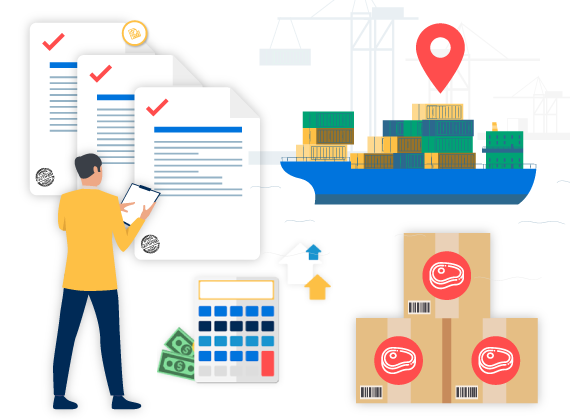
04 May
As the meat industry continues to evolve, the advent of artificial or cultured meat has captured the attention of many.
Ten years ago, the first lab-grown burger was introduced to the world. This event sparked excitement around the possibilities of artificial meat and its potential to revolutionise the industry.
With 2023 upon us, it’s natural to wonder how this year and beyond will shape the future of artificial meat and its impact on the global meat market.
Read on to gain insights into the potential trends and developments in both artificial and traditional meat sectors.
Artificial and Traditional Meat: The Key Factors
To better understand the implications for storage and export processes, it’s essential to comprehend how artificial and traditional meat is produced and the differences in their appearance.
Here are the primary distinctions that experienced meat exporters should consider:
Production
Traditional meat is produced by raising animals and using them for consumption. In contrast, artificial meat is produced by growing animal cells in a lab using tissue engineering techniques.
This process does not involve slaughtering animals and can potentially result in a more sustainable and ethical source of meat.
Appearance
Traditional meat has a distinctive appearance, with different cuts and textures depending on the animal and the part of the animal that is being consumed.
Artificial meat, on the other hand, is still in the early stages of development and may not yet have the same appearance as traditional meat. However, research is ongoing to produce artificial meat that is indistinguishable from traditional meat in terms of appearance and texture.
Nutritional Content
Traditional meat is praised for its highly digestible proteins, excellent amino acid composition, and abundant vitamins and minerals. Artificial meat is also a source of protein, but its nutritional content may differ from traditional meat.
The nutritional content of artificial meat is still being studied, and efforts are being made to create artificial meat that has similar nutritional value to traditional meat.
Safety
Artificial meat is produced in a sterile environment, reducing the contamination risk. However, safety concerns are still associated with producing artificial meat, such as the risk of contamination during the cell culture process. Traditional meat is often produced in a controlled environment following safety standards.
Cost
Artificial meat is currently more expensive than traditional meat due to the high cost of the technology and equipment used in production.
As a result, artificial meat is currently more expensive to purchase than traditional meat, which may limit its market appeal for the time being.
The Meat Market Landscape in 2023
As urbanisation and disposable income continue to increase globally, the demand for different meat products has also increased. This upward trend has been most evident in the consumption of chicken, beef, and pork meat products, leading to considerable growth in the traditional meat market.
However, artificial meat adoption has also taken place.
The ground beef segment is projected to witness significant growth in the traditional meat market, driven by changing consumer eating habits and a growing preference for red meat as a protein source. Additionally, pork meat products such as bacon, ham, sausages, and fresh pork meat have seen an increase in demand due to the upward trend in swine production, which holds the major storage space of animal husbandry.
Ground chicken is also experiencing substantial market growth, thanks to reducing feed prices and the growing awareness of food safety.
Optimising Your Meat Export Process: Capitalising on Global Traditional Meat Demand
As a meat exporter, you understand the importance of an efficient export process. However, there’s always room for improvement.
Consider these steps to enhance your operations:
Streamline Your Supply Chain Management
Create a comprehensive plan considering every aspect of the process, from sourcing raw materials to the final product delivery. Implementing a cloud-based supply chain management system can also help you manage your inventory and reduce wastage.
Invest in Quality Control and Assurance
Establish a robust quality control system covering everything from sourcing raw materials to final delivery. Regular testing and inspection of your products will ensure that your export process is efficient and meets customer expectations.
Ensure Compliance with International Regulations
Stay updated on the latest regulations in the countries you export to and ensure that your export process meets all the necessary standards.
Focus on Efficient Logistics Management
An efficient logistics management system can help you save time and money during your meat export process. Invest in a transportation management system that optimises the movement of your products from one location to another, reducing delivery times and costs.
Embrace Technology
Focus on streamlining your meat export process and use comprehensive software like ImpexDocs’ Global Trade Management Software to transform and optimise your global trade operations.
With a deep understanding of the export industry landscape, ImpexDocs’ Global Trade Management software can handle the complexities of global trade. The software works with fast-emerging market trends and keeps up with rapidly changing industry regulations.
Furthermore, it is designed to streamline your export processes and boost productivity. The user-friendly interface lets you easily manage your export documentation, compliance requirements, and logistics operations.
Summing Up
With the insights provided, you should now be better equipped to gauge the direction of the meat industry in 2023 and beyond.
Stay ahead of the competition by streamlining your export execution process with ImpexDocs‘ Global Trade Management Software. Our software solutions can simplify your export supply chain, allowing you to augment your growth while complying with rapidly changing industry regulations.


